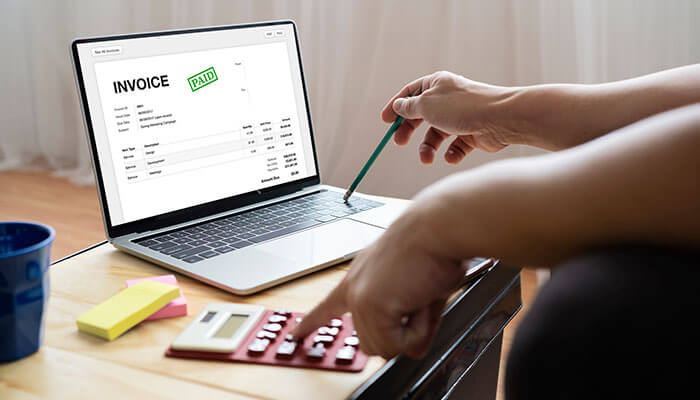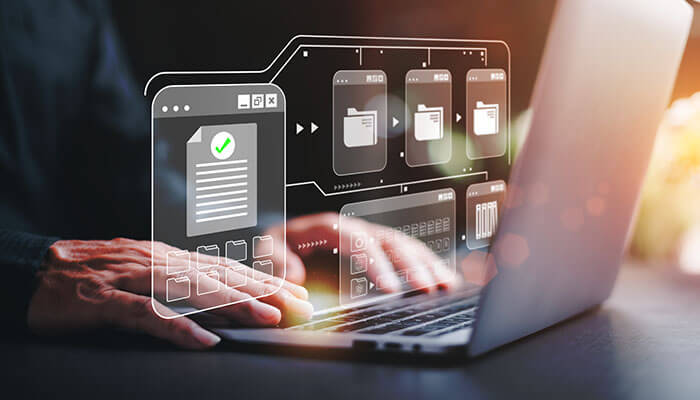During manual invoice processing, invoices received from a supplier are matched, verified, and approved. The entire process is elaborate and takes several days. But that’s not all – each invoice must be manually entered into the system to be posted for payment. Finally, the payment is made. The entire process can take weeks. That means your vendors will have to wait weeks for their payment. Any delays or errors can further detain payments.
Automated invoicing gets to the point:
Invoice data extraction automation
When an invoice arrives (via email or fax, as a digital image, PDF, XML, or any other form) – it must be scanned. Data must be extracted and fed into the digital accounting system.
Invoice data extraction automation is the first step of invoice automation. In automated invoice processing, automated invoice data extraction is the process of extracting critical data (invoice number, vendor’s name, amount, etc.) from each invoice so the software/system can quickly analyze and enter that data into the accounting system.
There are three data capture/extraction methods commonly used in automated invoice processing:-
1. Template based OCR
Template-based OCR is one of the first technologies used in data extraction. OCR or Optical Character Recognition converts text from an image (invoice in this case) into machine-readable text. Traditional OCR could isolate and extract only relevant data placed at a specific position in a document – for example, date, document number, or address on an invoice/document. However, that meant that invoices had to follow a particular template, and any deviation from that template could lead to false data extraction and require additional configurations.
The disadvantages of template-based OCR are: To further simplify invoice operations, businesses can utilize tools like the InvoiceSimple invoice software, which enhances efficiency and professionalism by streamlining the creation, management, and sending of invoices. Such software is particularly beneficial for small businesses seeking to save time and ensure quicker payments while maintaining professional standards.
- Documents must be processed following very specific templates and rules.
- Today, organizations must process a wide variety of invoices coming in from multiple clients. The more diversity in these invoices, the harder it is for OCR to keep up.
- Any deviation from a template can lead to inaccuracy.
- The technology lacks adequate automation.
- OCR cannot extract context from content, making it impossible to interpret data.
- Template-based OCR ends up requiring a lot of manual intervention for data processing.
2. Computer Vision
What is needed today is automated data extraction that can extract fine-grained data from multiple types of invoices. But it also needs computer vision and natural language to validate that extracted data so it can be used by downstream software.
3. Intelligent Document Processing
Intelligent data processing (IDP) intelligently extracts data and can easily recognize various text patterns and characters. It uses artificial intelligence (AI) and machine learning (ML) to capture data from pdf, images, and other documents intelligently like a human, but faster and with precision. Intelligent Document Processing automates data extraction from various documents and sources, streamlining integration with core operations, reducing manual effort, overcoming complex document layout challenges, and ensuring compliance with legal requirements. The entire data capture process can be completed in minutes by:
- Enhancing images (invoices) for better quality data extraction.
- Identifying a line of text at a time (segmentation).
- Identifying characters through matrix matching (checking individual characters against a character matrix database) and feature recognition (identifying text patterns and recognizing characters from photographs)
- Using algorithms for increased data extraction accuracy.
Invoice routing and automation approval
The approval process is another critical step in invoice automation. Here, invoices are routed for approval based on a business’s specific invoice approval automation rules. Invoices can be segregated according to invoice type, vendor, amount, etc., and then sent to particular people for approval. Any invoice with discrepancies is escalated so it can be manually reviewed.
Other steps involved in invoice automation
A report containing all the invoice data is created and goes through the general ledger coding process. Once coded, the information is exported to the ERP system for final approval and payment.
Finally, all processed invoices are archived for audit purposes and to maintain a reference of each vendor/supplier’s payment history.



